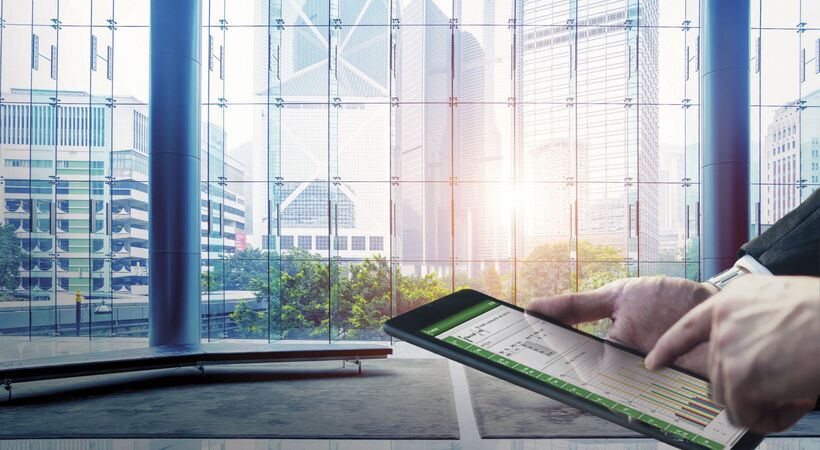The changing nature of power has redefined electrical consumption and distribution for today’s buildings and businesses. Population growth and a burgeoning number of connected devices and infrastructure has fuelled spiralling energy demands, with consumption expected to double by 2040. With 70 per cent of that new power to be generated by cleaner but less predictable renewable sources, how we distribute this energy becomes all-important. This new power paradigm is forcing facilities managers to reconsider energy management. Yet many are rising to the occasion with digitised solutions that not only make distribution more efficient, but their buildings cheaper to run.
The changing nature of power
There have already been huge changes in how power is generated and used in recent years. With the challenges of rapid population growth and spiralling energy demand in our current climate, innovations in power generation are providing new solutions. Compared to just a few years ago, there has been a huge increase in multi-source power generation, decentralised grids, decarbonisation, renewable resources, and electrical distribution management. Without a doubt, great work has been done to evolve and meet demand in a sustainable, efficient way.
However, while this innovation does combat many issues, it also presents businesses with substantial operational challenges. Buildings and facilities consume a great deal of energy while power assets incur significant operational costs, and the traditional distribution and monitoring systems that run them cannot handle the more dynamic and multi-directional nature of power. Unless addressed, this setback may become a barrier to further progression, placing a cap on the potential of the evolution of power. In order to shape the greatest possible future for power, a complete transformation of these systems is needed. The way buildings work must be revolutionised from the inside out.
Adaptation and digitisation
The more digitised a building becomes, the better it will be able to adapt to the changing nature of power. Digitisation is having an enormous impact on the world in general, but it has a particular transformative effect on buildings and distribution.
There are numerous trends in building operations that reveal the future shape power distribution may take. The ubiquity of the Internet of Things (IoT) has had a massive influence in the past five years. The more a building’s devices can connect to one another, the more optimised they can become. Beyond this, by adopting autonomous building and industrial systems, facilities can maximise efficiency without the need for human intervention. This of course limits the chance of human error slowing the system down.
The convergence of technical systems is also important to consider. As stand-alone building management systems (BMSs) begin to phase out, power and energy management will merge with other systems for simplified and streamlined reporting and maintenance; integration of systems becomes the focus. This is made possible by today’s IoT-enabled smart building platforms which integrate and monitor systems through connected sensors. All data is then stored to a central hub for use by the building’s managers. At the same time, the widespread decentralisation of energy sources reduces reliance on any one energy source. This way, facilities can increase flexibility and productivity, while reducing supply-chain risks.
This is further aided by the pervasive growth of mesh networking in buildings and infrastructure. Supported by high-efficiency and reliable wireless communications, with nodes that communicate dynamically with each other, buildings can host a fast and effective communications network. With mesh networking, this will remain true even as the number of data points grows.
Ultimately, the more digitised a building and its systems becomes, the better it can handle the demands brought by the evolution of power. As an added bonus, buildings will become more efficient and comfortable for occupants as well.
Small but vital steps
As digitisation represents the future of power distribution, it is essential that building and facility managers start to lay the groundwork. Yet what practical steps can they take to keep up with this evolving landscape?
First of all, installing connected products is a vital step. Only install devices that can be connected to the power management system for comprehensive, real-time updates. As an example, IoT-connected smart panels provide electrical equipment the ability to present data on your computer or smart device in real-time, allowing you to pinpoint overloads and inefficiencies proactively, stop chasing vague alarms, and reduce costs. This can be as simple as adding a IoT-connected sensor, such as Schneider Electric’s PowerTag into a single circuit breaker that will constantly monitor energy consumption, device condition and circuit health.
The next move should be to run power management software. By connecting devices to edge control software, you can analyse data to gain a better understanding of your power network. For medium to large facilities these solutions are ideal, collecting and organising all the data gathered from your facility’s network and allowing managers to maximise uptime, reduce costs and increase profitability. In smaller buildings, user-friendly and cost-effective mobile apps can be equally effective.
Finally, it is imperative to have more accurate insights. By using analytics, apps, software, and services that are available today, you can find ways to increase efficiency, improve safety, and cut costs. For example, with Schneider Electric’s EcoStruxure Facility Advisor, businesses of all sizes can improve the performance of their buildings, ensuring business continuity while optimising operations and limiting downtime.
The more digitised a building and its systems becomes, the better it can adjust to the new power paradigm. At the same time, IoT-connected solutions like those offered by Schneider Electric enable facilities to become more efficient and comfortable for their occupants. Steps taken today to adopt superior analytics and power management software can alter a building’s makeup and enhance distribution. Ultimately, smarter buildings are cheaper and more efficient buildings.



